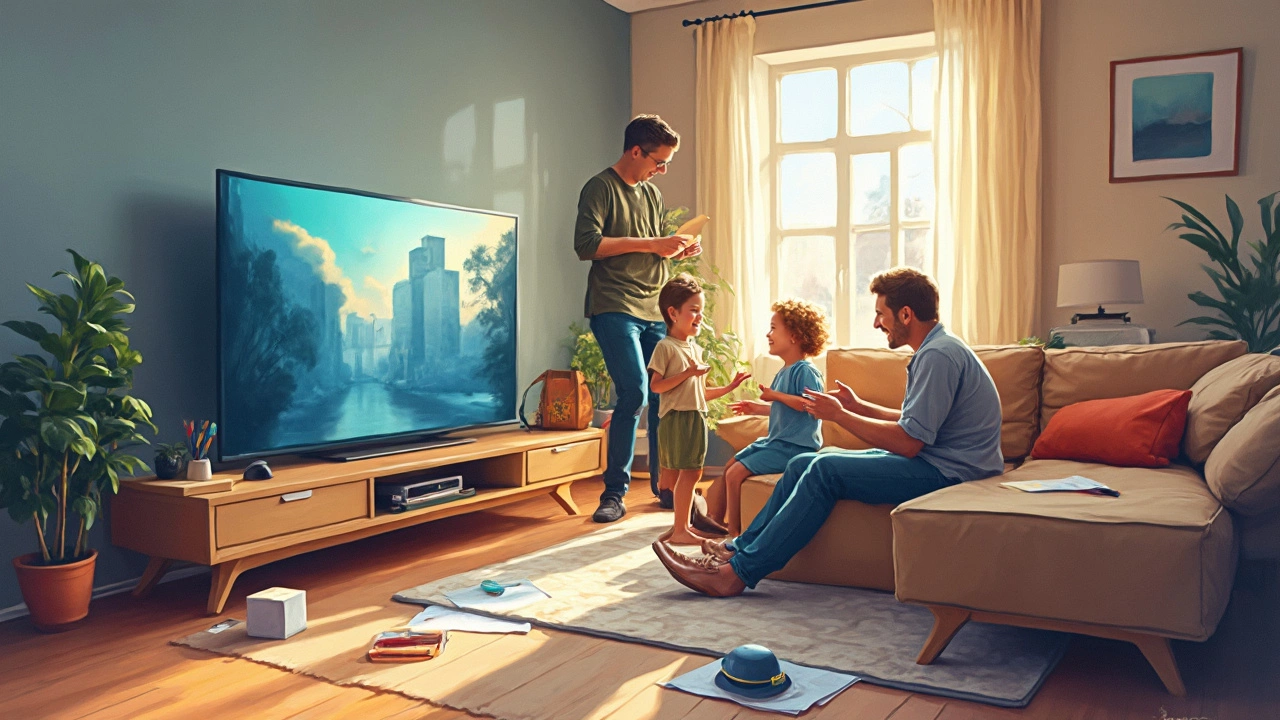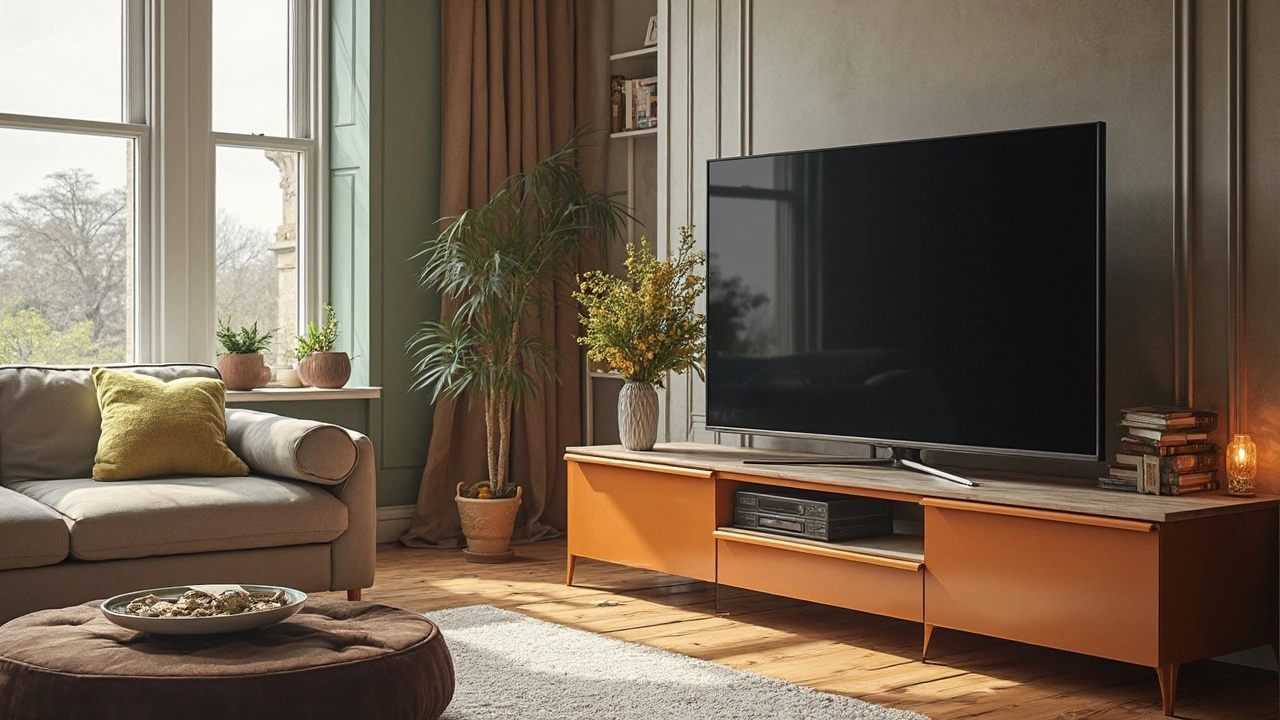Wondering how wide a 65-inch TV typically is? Well, that's a great question especially if you're planning on upgrading your home's entertainment setup. The width of most 65-inch TVs is usually around 57 inches, but it's good to be aware of variations depending on the brand and model. So, measuring your space is essential to avoid any surprises after you've brought that big screen home!
Getting the right width matters because it affects how well your TV fits on your stand or within your entertainment center. You don't want it sticking out awkwardly or being crammed into a space that's too tight. Plus, knowing the exact width helps in picking out the perfect TV stand. You want that balance between a sleek look and sturdy support.
- Standard Dimensions of a 65-Inch TV
- Why TV Width Matters
- Choosing the Right TV Stand
- Common Mistakes and How to Avoid Them
- Final Tips for Perfect Placement
Standard Dimensions of a 65-Inch TV
When we're talking about a 65-inch TV, we're really referring to the diagonal length of the screen. But if you're trying to figure out where that bad boy will fit, you need to know the width, which generally comes in at about 57 inches. This accounts for the screen and the border or bezel, which can vary in size depending on the brand and model.
Most 65-inch TVs have an aspect ratio of 16:9, meaning that for every 16 units of width, there are 9 units of height. This not only influences the TV's shape but also its total dimensions. Typically, you can expect the height to be around 32 inches. Throw in a few inches for the base or stand, and you've got a pretty good size reference.
Now, not all manufacturers stick to the same bezel size. Some might offer ultra-thin bezels, which make the screen seem even bigger without actually changing the viewing size. That said, always check the specs on the brand you’re eyeing. They provide exact measurements, so you won't have to guess.
If you're not a fan of numbers in text, here's a quick look at the average dimensions:
| Measurement | Average Size |
|---|---|
| Width | 57 inches |
| Height | 32 inches |
| Diagonal | 65 inches |
Keep in mind, these are rough averages, and selecting the right TV depends on more than just these numbers. Plan for a bit of extra space surrounding the TV, especially if you’re considering wall-mounting. Being prepared ensures that you won’t struggle with fitting it into your living space, and it makes the whole process less of a hassle.
Why TV Width Matters
Ever wondered why the width of your TV is such a big deal? Well, there's more to it than you might think. When you're dealing with something as sizeable as a 65-inch TV, the width becomes crucial in planning your space. It's not just about fitting the TV onto your stand but ensuring that it's positioned in a way that enhances your viewing experience.
If your 65-inch TV is too wide for its spot, you might find yourself with an awkward setup where you either block part of the screen or, worse, risk knocking it over because it's precariously balanced. That would be a disaster with today's massive investments in high-quality screens!
Having the right width also helps distribute the TV's weight evenly across the stand, giving it the stability it needs. You don’t want your favorite movie marathon interrupted by a tumble, right? The correct width ensures everything holds together smoothly.
Here's a neat tip: when measuring for a TV stand, make sure it’s at least a couple of inches wider than your TV, ideally more. This provides room for any extra wiggle and incidentals like gaming consoles or streaming devices.
To break it down:
- Your TV stand should be at least as wide as the TV.
- The width impacts both aesthetics and safety.
- Proper width placement enhances viewing angles and comfort.
Getting the measurements right means you can sit back and enjoy without worrying if your setup is on solid ground. Trust me, it's the difference between a seamless grocery trip and realizing you forgot the very thing you went for!

Choosing the Right TV Stand
Getting a new TV is great, but it’s important to pair it with the right TV stand. You might think any stand will do, but choosing wisely can make a big difference in your living space's look and feel. First off, think about the TV dimensions. For a 65-inch TV, your stand needs to be at least as wide as the TV itself, which means at least 57 inches. This will ensure your TV won’t tip over easily and looks well-proportioned.
Besides the width, pay attention to the stand’s height. Ideally, the center of your TV screen should be at eye level when you're seated. This ensures a comfortable viewing experience without neck strain. Most folks make the mistake of either getting something too high or too low, making movie nights a stretch.
Consider the style and material of the stand too. Do you need extra shelves for consoles and game systems? Or maybe some storage for DVDs and remotes? Wooden stands are durable and give a cozy vibe, while glass or metal options can make your space feel modern. It’s all about what fits your room’s aesthetic.
| Material | Pros | Cons |
|---|---|---|
| Wood | Durable, classic look | Can be bulky |
| Glass | Stylish, modern look | Can be fragile |
| Metal | Sleek, durable | Can be heavy |
Don't forget about cable management. A great TV stand will have good ways to hide all those messy cords. This not only makes your setup look neat but also keeps things safe by preventing trips over wires.
When shopping, also check the stand's maximum weight capacity. Make sure it can handle your TV's weight comfortably. It's better to go a little over than under on this one.
Common Mistakes and How to Avoid Them
Alright, so you’ve got your eye on that new 65-inch TV, but before you jump in, let's talk about some common oopsies people make that you definitely want to avoid. First off, assuming all 65-inch TVs have the same dimensions can lead to a disaster when the setup day rolls around. Different models can have varying bezels and design elements that change the TV dimensions a bit.
One classic blunder is not measuring the space where you plan to place the TV. Just eyeballing it isn’t enough. You need a tape measure to check that the TV width fits the spot perfectly, leaving room for any additional electronic components or speakers you might want to add.
Another mistake is neglecting ventilation. It sounds trivial but packing your TV into a tight spot without adequate airflow can overheat the electronics. To avoid that, ensure there's at least a few inches of space around the TV for air to circulate.
Also, setting up your TV at the wrong height can wreck your viewing experience. Ideally, the center of the TV screen should be at eye level when you're sitting down. It might seem like a minor detail now, but your neck will thank you later!
- Measure your space carefully before buying.
- Ensure proper ventilation around your TV.
- Maintain eye-level alignment for comfort.
Let's not forget about TV stands. Picking a stand that’s too small or unstable is a common pitfall. Choosing the right TV stand means ensuring it is wider than your TV and sturdy enough to support its weight. Go with a style that complements your room’s decor while keeping safe support in mind.

Final Tips for Perfect Placement
Alright, so you've got your eyes on that 65-inch TV and you're eager to set it up perfectly. Let's make sure everything is spot-on so you can get the best viewing experience possible.
First things first, measure your setup area. You'd hate to have a gorgeous TV arrive and not have enough space. If your TV stand doesn't work, measure out a spot on the wall for mounting. Speaking of mounting, put that screen at eye level when seated for the comfiest viewing angle.
Light glare can be a real drag when you’re trying to enjoy a movie. Think about where your TV will catch light from windows or lamps. A little rearrangement can make a big difference. And hey, if you’re going the wall mount route, make sure the mount supports the weight and dimensions of your 65-inch screen, which are generally around 57 inches wide.
Want to make sure your audio is on point too? Check the distance your speakers are from the TV and where you’re sitting. The general rule of thumb is three times the TV screen size for the optimal viewing distance, which means about 8 to 13 feet. You may want to adjust your seating for the full home theater vibe.
Need some technical specs? Here’s a quick reminder:
| Screen Size | Width | Recommended Viewing Distance |
|---|---|---|
| 65 inches | Approx. 57 inches | 8-13 feet |
To cap it all off, make sure your cables are tidy. You don’t want a mess of wires spoiling the aesthetic. Velcro wraps or cord covers are lifesavers here. Now you're all set to enjoy some epic screen time!


Write a comment